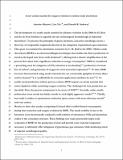| dc.contributor.author | Allanore, Antoine | |
| dc.contributor.author | Yin, Lan | |
| dc.contributor.author | Sadoway, Donald Robert | |
| dc.date.accessioned | 2013-11-12T13:14:25Z | |
| dc.date.available | 2013-11-12T13:14:25Z | |
| dc.date.issued | 2013-05 | |
| dc.date.submitted | 2012-10 | |
| dc.identifier.issn | 0028-0836 | |
| dc.identifier.issn | 1476-4687 | |
| dc.identifier.uri | http://hdl.handle.net/1721.1/82073 | |
| dc.description.abstract | Molten oxide electrolysis (MOE) is an electrometallurgical technique that enables the direct production of metal in the liquid state from oxide feedstock and compared with traditional methods of extractive metallurgy offers both a substantial simplification of the process and a significant reduction in energy consumption. MOE is also considered a promising route for mitigation of CO[subscript 2] emissions in steelmaking, production of metals free of carbon, and generation of oxygen for extra-terrestrial exploration. Until now, MOE has been demonstrated using anode materials that are consumable (graphite for use with ferro-alloys and titanium) or unaffordable for terrestrial applications (iridium for use with iron). To enable metal production without process carbon, MOE requires an anode material that resists depletion while sustaining oxygen evolution. The challenges for iron production are threefold. First, the process temperature is in excess of 1,538 degrees Celsius. Second, under anodic polarization most metals inevitably corrode in such conditions. Third, iron oxide undergoes spontaneous reduction on contact with most refractory metals and even carbon. Here we show that anodes comprising chromium-based alloys exhibit limited consumption during iron extraction and oxygen evolution by MOE. The anode stability is due to the formation of an electronically conductive solid solution of chromium(iii) and aluminium oxides in the corundum structure. These findings make practicable larger-scale evaluation of MOE for the production of steel, and potentially provide a key material component enabling mitigation of greenhouse-gas emissions while producing metal of superior metallurgical quality. | en_US |
| dc.description.sponsorship | American Iron and Steel Institute | en_US |
| dc.language.iso | en_US | |
| dc.publisher | Nature Publishing Group | en_US |
| dc.relation.isversionof | http://dx.doi.org/10.1038/nature12134 | en_US |
| dc.rights | Article is made available in accordance with the publisher's policy and may be subject to US copyright law. Please refer to the publisher's site for terms of use. | en_US |
| dc.source | Prof. Allanore via Angie Locknar | en_US |
| dc.title | A new anode material for oxygen evolution in molten oxide electrolysis | en_US |
| dc.type | Article | en_US |
| dc.identifier.citation | Allanore, Antoine, Lan Yin, and Donald R. Sadoway. “A new anode material for oxygen evolution in molten oxide electrolysis.” Nature 497, no. 7449 (May 8, 2013): 353-356. | en_US |
| dc.contributor.department | Massachusetts Institute of Technology. Department of Materials Science and Engineering | en_US |
| dc.contributor.approver | Allanore, Antoine | en_US |
| dc.contributor.mitauthor | Allanore, Antoine | en_US |
| dc.contributor.mitauthor | Yin, Lan | en_US |
| dc.contributor.mitauthor | Sadoway, Donald Robert | en_US |
| dc.relation.journal | Nature | en_US |
| dc.eprint.version | Author's final manuscript | en_US |
| dc.type.uri | http://purl.org/eprint/type/JournalArticle | en_US |
| eprint.status | http://purl.org/eprint/status/PeerReviewed | en_US |
| dspace.orderedauthors | Allanore, Antoine; Yin, Lan; Sadoway, Donald R. | en_US |
| dc.identifier.orcid | https://orcid.org/0000-0002-2594-0264 | |
| mit.license | PUBLISHER_POLICY | en_US |
| mit.metadata.status | Complete | |
